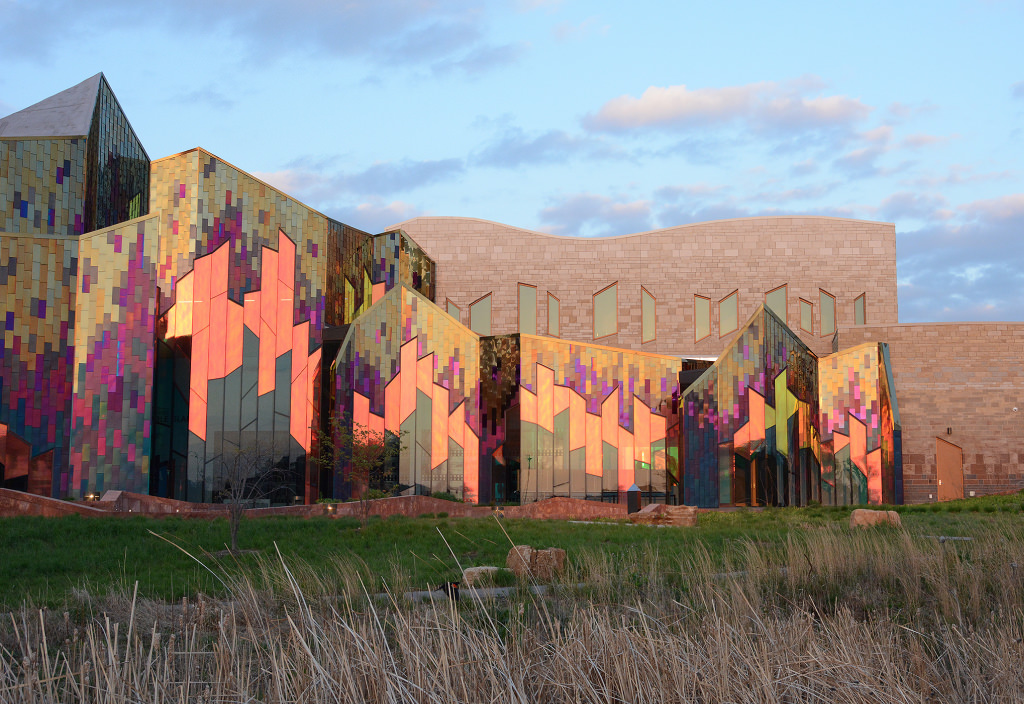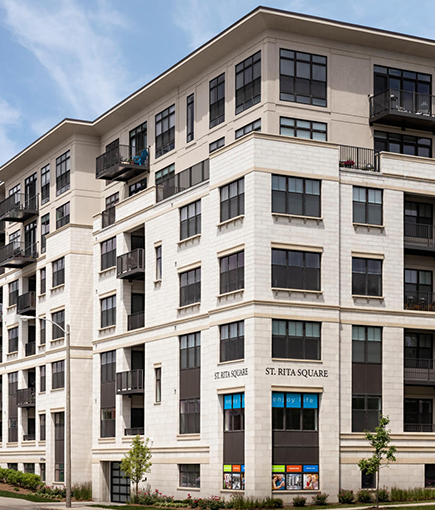
Stone and Fire: The Museum at Prairiefire Blends Natural and Man-Made Materials to Create an Architectural Icon on the Midwestern Prairie
Backround
The Museum at Prairiefire, located in Overland Park, Kansas, tells a story of geology, culture and the practice of prairie landscape management through intentional burns. The 41,000 sq. ft. architectural marvel, with a stone-clad backdrop that represents the undulating hillside, is alive with fiery sparks of color.
The fire element is represented by a unique film material and the stones are in vast range of colors. The museum features a rotation of exhibits from New York City’s American Museum of Natural History (AMNH).
The Challenge
The vision of Jonathan Kharfen, AIA, LEED senior associate, Verner Johnson Inc. of Boston, MA, the stonework is a mix of regionally-source natural limestone and manufactured stone veneer from Oldcastle’s Echelon product line, set by the masterful hands of D&D Masonry. With a budget of $17.1 million, the Museum at Prairiefire has won several awards and recently achieved a LEED Silver rating.
The Solution
Because Mother Nature doesn’t always have the colors you want in stock and at the right price, Kharfen went with manufactured stone veneer for the darker spectrum to achieve the desired “charred” gradient effect. “We incorporated four standard Echelon Cordova veneer colors and then worked closely with Oldcastle to create two custom colors,” said Kharfen.
For the second-floor stone balcony, with views of the wetlands park, a specialized wall system was required. “The design intent was for this cantilevered stone promontory to be completely wrapped in stone, even its sloping soffits,” said Kharfen. With the help of an Oldcastle subsidiary, Kharfen became familiar with the IBP Fast Track Stone System, which allows kerfed stone to sit in a lipped track system, which mechanically holds the stone in place, despite the gravity load of the sloping soffit. The two long sides of each stone are secured in the track top and bottom.
Kharfen sloped the headers (and sometime sills) of all windows and doors located in the stone walls. Concerned about the stone cracking at these unique and sometimes extreme header geometries, Kharfen found a clever way to support the stone to minimize any potential cracking over time. Whereas a typical window lintel spans horizontally to the window jambs, Kharfen designed a double lintel with a horizontal leg as well as a sloped leg.
The sloped leg only supports the minimal triangular area of stone directly above the window, with the horizontal leg supporting the rest of the stone above, thereby minimizing the potential for cracking. “You can’t tell when you see it, that there are two lintels above each window and door,” he said.
The Result
Like a proud parent, Kharfen beams with pride when he talks about the Museum at Prairiefire, with its seamless blend of natural and man-made materials and incredible colored film that creates a kaleidoscope of colors against the exquisitely crafted stone backdrop. Like a splendid Phoenix rising from the ashes, the Museum at Prairiefire will dazzle visitors for generations to come.
- Product
- Cordova Stone
- Architect Firms
- Verner Johnson, Inc.
- Lead Architect
- Jonathan Kharfen, AIA and LEED Sr. Assoc. - Verner Johnson
- Masonry Contractor
- D&D Masonry
Stay Connected
Get the latest news and information from Echelon by signing up to receive our monthly newsletter.

Cordova Stone
- Key Specifier Documents
- Specification Document
- Cut Sheet
- Download BIM Content
Featured Product
Cordova Stone
Manufactured by Northfield Block Company, Cordova STONE high-density pre-finished architectural masonry units combine all-natural aggregates with concrete masonry to create the beauty of natural stone with the structural integrity of concrete. Available for both veneer or through-wall applications in a variety of textures, colors, shapes and sizes, Cordova STONE offers unlimited interior and exterior design options, including archways, coping, and sills. Cordova STONE’s newest look, Chiselface, offers a sophisticated dimensional texture with the hand-chiseled look of natural-cut limestone. Easily cut and shaped in the field, installation is a breeze. Designed to last, Cordova STONE is mold and moisture resistant, provides a high degree of cleansability, requires virtually no maintenance, and outperforms all ASTM requirements for strength and durability.